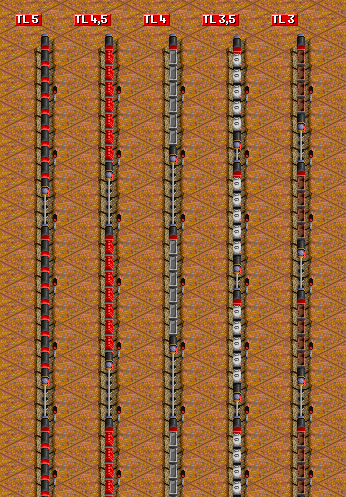Difference between revisions of "User:Tim/Tilelength"
From #openttdcoop wiki
m |
|||
| Line 8: | Line 8: | ||
If you look at the picture to the right, you will see that with "Place signals every 2 Tiles", trains with different tilelengths use the given space quite differently. While the trains with "natural odd" Tilelengths (3 and 5) have almost no space between them, the trains with other Tilelengths such as 3,5; 4 or 4,5 have quite some space between them - space which could be used more efficiently! However, to achieve that, you would have to place a signal each 5 tiles (with the example of Tilelength 4), which you can't do with the patch-setting of "Place signals every 2 Tiles", you would have to set this setting to either 5 or 1, both are not very satisfying solutions. | If you look at the picture to the right, you will see that with "Place signals every 2 Tiles", trains with different tilelengths use the given space quite differently. While the trains with "natural odd" Tilelengths (3 and 5) have almost no space between them, the trains with other Tilelengths such as 3,5; 4 or 4,5 have quite some space between them - space which could be used more efficiently! However, to achieve that, you would have to place a signal each 5 tiles (with the example of Tilelength 4), which you can't do with the patch-setting of "Place signals every 2 Tiles", you would have to set this setting to either 5 or 1, both are not very satisfying solutions. | ||
| + | |||
| + | However, this applies for straight tracks, if you look at diagonal tracks, the situation is almost the same. Here the trains with Tilelengths of 3,5 or 5,5 or 7,5... fit perfectly, while with TL 3 or 5 you have small gaps. Those are, however, still a lot smaller than those with TL 2 or 4 or 6. | ||
[[Image:Diagonal_Comparison_of_Tilelengths.png|thumb|346px|Diagonal Comparison of the same TLs]] | [[Image:Diagonal_Comparison_of_Tilelengths.png|thumb|346px|Diagonal Comparison of the same TLs]] | ||
Revision as of 22:25, 3 February 2008
Introduction
Whenever starting a new game, one of the first settings to be chosen is the used tilelength for your trains. This length can vary from supersmall trains with only three carriages (which would be tilelength 2) to huge mammoth trains with more than 20 carriages, which would make a tilelength greater than 10...
Why Odd Tilelengths are better than Even Ones
Most people probably play with the Patch-Option "When Dragging, place Signals every: X Tiles" set to 2, accordingly there will always be one tile with a signal on it, one without one, one with a signal and so on. In #openttdcoop games, this is an undiscussed standard. As we do not want to change this setting, we should see how we can fit the tilelength of our trains to it. A common situation is that one or more trains are waiting before a station which is currently full. Those waiting trains could jam back until the mainline of our network and block it. The jammed part of the mainline would jam too and block other parts of the mainline, until the mess is complete. To avoid a situation like this, you can take various measures like expanding the jammed station or the waiting space before it. But just by choosing an odd tilelength, you can already ease the situation.
If you look at the picture to the right, you will see that with "Place signals every 2 Tiles", trains with different tilelengths use the given space quite differently. While the trains with "natural odd" Tilelengths (3 and 5) have almost no space between them, the trains with other Tilelengths such as 3,5; 4 or 4,5 have quite some space between them - space which could be used more efficiently! However, to achieve that, you would have to place a signal each 5 tiles (with the example of Tilelength 4), which you can't do with the patch-setting of "Place signals every 2 Tiles", you would have to set this setting to either 5 or 1, both are not very satisfying solutions.
However, this applies for straight tracks, if you look at diagonal tracks, the situation is almost the same. Here the trains with Tilelengths of 3,5 or 5,5 or 7,5... fit perfectly, while with TL 3 or 5 you have small gaps. Those are, however, still a lot smaller than those with TL 2 or 4 or 6.

